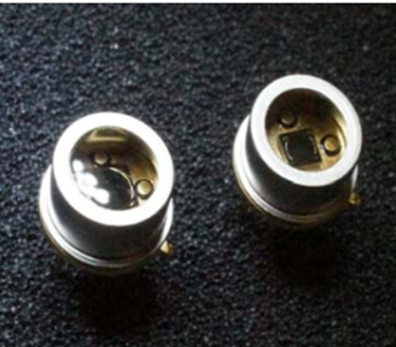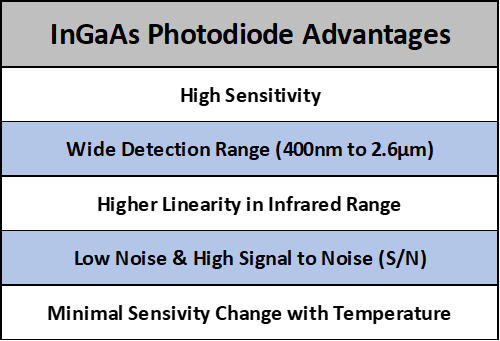Marktech Optoelectronics, Inc. (Marktech), a privately-held leading designer and manufacturer of standard and custom optoelectronics, including UV, visible, near-infrared (NIR), and short-wavelength infrared (SWIR) emitters, detectors, InP epi wafers, and other compound semiconductors, today revealed their latest lineup of advanced Indium Gallium Arsenide (InGaAs) photodiode photodetectors.

Marktech’s standard InGaAs photodiode detector in a TO metal can package are available through Digikey Electronics and Mouser Electronics.
Marktech's InGaAs photodiode manufacturing facility in Japan is recognized as producing some of the industry's highest integrity visible through SWIR detectors. As a result, Marktech can cross many competitors' InGaAs photodiodes with a product having specifications matching or exceeding the competitive specifications. After prototype approvals and receipt of required materials, our typical delivery times for custom InGaAs photodiodes are shorter than similar products from leading photodiode manufacturers. In addition, many standard InGaAs photodiodes can be delivered from our existing inventory in a few days through our distributor websites, Digikey Electronics and Mouser Electronics.
InGaAs Photodiodes (InGaAs PDs)
Marktech's lineup of advanced InGaAs photodiode detectors consists of several detector families or series based on their spectral sensitivity ranges:
- Vis-NIR-SWIR – 600nm to 1700nm spectral sensitivity
- NIR-SWIR-Extended SWIR – 800nm to 2600nm spectral sensitivity
InGaAs PIN photodiodes are available in various package types such as hermetically sealed metal cans (TO-5, TO-18, and TO-39), ceramic SAW packages, pigtail cans, 3mm molded plastic through-hole (flat lens or dome ceramic), and Marktech's latest enhanced SMD packaging system, the hermetic ATLAS package.

Gakos Chamber for InGaAs Photodiode Detector Fabrication on 4 inch InP Wafers
Marktech is an integrated manufacturer engineering and fabricating InGaAs devices at the wafer level and then packaging and assembling InGaAs die into completed detector products. This high level of integration ensures the highest quality, integrity, and traceability throughout the production process. Marktech’s combination of design and manufacturing expertise in both compound semiconductor device fabrication and optoelectronic packaging allows Marktech to reduce size, weight, and power (SWaP) of InGaAs detector products for their customers. Reduced SWaP is increasingly crucial to design engineers as miniaturization efforts continue to enable the development of new wearables, portable instruments, and compact photonics products.
InGaAs Overcomes the Limitations of Silicon and Germanium
While silicon (Si) is an excellent material for light detection below 1.1μm (1100nm) and even light guiding above wavelengths of 1.1μm. III–V semiconductor materials like InGaAs can provide detection and emission at telecom wavelengths (1.31~1.55μm) and SWIR wavelengths (1.4 – 3.0 μm) due to the intrinsic material properties of InGaAs. InGaAs photodiodes are widely utilized in infrared spectroscopy because InGaAs detectors have higher linearity in the infrared spectrum than silicon. The high sensitivity of InGaAs detectors combined with low noise characteristics (high signal/noise ratio) in the NIR and SWIR wavelengths make InGaAs highly desirable for:
- Photoluminescence or fluorescence spectroscopy
- IR laser diode characterization and monitoring
- Non-dispersive infrared (NDIR) spectroscopy
- Scanning or dispersive NIR spectroscopy
- Emerging infrared spectroscopy methods
In addition, InGaAs photodiodes have more thermal stability or a lower temperature coefficient of sensitivity (< 0.1% / K) over a wider range of wavelengths than silicon.

Marktech’s InGaAs Photodiode Advantages
Marktech's InGaAs photodiodes provide high sensitivity, high speed, low noise, excellent linearity, high quantum efficiency, low-temperature coefficient of sensitivity, low dark current, better shunt resistance, improved low operating temperature performance, and durability combined with an extended lifetime at a reasonable cost.

Our InGaAs photodiodes are ideal as the primary detector elements in non-dispersive spectrometers (Vis-NIR-SWIR), photometers, free space optic communications systems, LiDAR, laser distance rangefinders, and semiconductor defect inspection instruments. In addition, Marktech's infrared monitoring photodiodes can measure optical power output of NIR and SWIR lasers and light sources, which is a critical element in the feedback and control of laser output.
Custom Photodetectors to OEM Specs
Marktech has extensive capabilities to design and manufacture custom photodetectors to OEM specifications from prototype to production volumes. Marktech's custom photodetector engineering and manufacturing range includes custom InGaAs photodiodes (wafers, die, packaged InGaAs PDs, and assemblies). In addition, Marktech can co-package InGaAs photodiodes with emitters, filters, and transimpedance amplifiers (TIAs). Our InGaAs photodiodes from Japan and silicon photodiodes from our Simi Valley plant have been assembled in the same package for wide spectral band detection applications – from 2600nm to 250nm (SWIR/MIR to mid UVB).
Consult with Us Today About Your Design Project
Marktech Optoelectronics has vertically integrated capabilities to custom design and fabricate InGaAs photodetector and InGaAs photodiode array devices on wafers and then dice and package these photodiode chips with any required emitters, amplifiers, filters, and components for specific applications. This vertical integration allows Marktech to precisely control the performance and quality of the photodetectors and assemblies designed and manufactured for our customers.
For more details, the full version of this press release is available here: Marktech Optoelectronics Reveals Latest Lineup of Advanced InGaAs Photodiode Photodetectors
If you have specific technical or application questions regarding your optoelectronics design project or are just interested in learning more about Marktech’s silicon photodiodes, then please reach out to us through the following:
- Contact our application engineers: [email protected]
- Request for information (RFI) or request for quote (RFQ) form: Contact Us